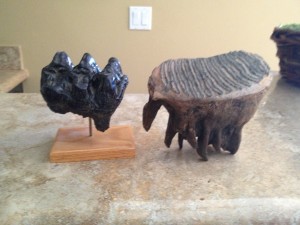To most people, the differences between mammoths and mastodons are trivial. What’s one prehistoric elephant to another, right? Wrong. Despite looking similar and coexisting in some parts of the world, mammoths and mastodons are two very different animals. For starters, neither mammoths nor mastodons are technically elephants. Mammoths, mastodons, and elephants belong to a group of animals known as proboscideans. Mammoths and elephants are very closely related, whereas mastodons are a little more distant on the evolutionary tree. Mastodons appear in the fossil record about 28 million years ago, while mammoths don’t appear until about 4 million years ago. Mammoths were animals of the grasslands and plains while mastodons preferred more forested habitats. We can tell this from looking at the animals’ teeth. Mammoths are grazers with large, flat molars covered in ridges for grinding tough, silica-rich grasses. Mastodons are browsers, with low-crowned molars with pointed cusps meant for dealing with leaves, branches, and twigs. Both animals were large, but overall mammoths were larger. The largest mammoths could weigh 10 tons and stand over 15 feet at the shoulder while mastodons weighed about 5 tons and were 10 feet at the shoulder. Mammoths are long-limbed with a relatively short torso and curved tusks, whereas mastodons are more stocky and robust with barrel-chests and straighter tusks. Unlike mammoths, which only have tusks in the upper jaw, some mastodon species had tusks in both the upper and lower jaws. Mammoths and mastodons have the same total number of teeth, but mastodons had two molars exposed per jaw at a given time versus the mammoths’ one.

